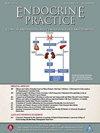Growth Hormone and Bone: Preclinical and Clinical Perspectives
IF 4.6
3区 医学
Q2 ENDOCRINOLOGY & METABOLISM
引用次数: 0
Abstract
Objective
Growth hormone (GH) is essential for growth and bone metabolism. This article reviews preclinical data that has shaped our understanding of the mechanisms underpinning the effects of GH on bone beyond the downstream activation of insulin-like growth factor-I (IGF-I) generation and summarizes the clinical data of GH deficiency (GHD) and acromegaly on bone health parameters and fracture risk.
Methods
A literature search was conducted on PubMed using the following key words: GH, IGF-I, bone, GHD, and acromegaly. The discussion of therapy in GHD and patients with acromegaly, and their fracture risk assessment was based on evidence derived from previously published preclinical and clinical studies.
Results
Preclinical and clinical data have demonstrated important pleiotropic effects of GH and IGF-I on bone formation and resorption. GH exerts direct and IGF-dependent and independent effects on bone, while IGF-I acts in an endocrine and autocrine/paracrine manner. In GHD, decreased bone turnover, delayed statural growth, low bone mass, and increased fracture risk are observed, whereas acromegaly is associated with increased bone turnover but decreased lumbar bone mineral density and increased vertebral fracture and osteoarthritis risk. Treatment aimed at normalizing the GH/IGF-I axis decreases the fracture risk in GHD, but not acromegaly.
Conclusion
Preclinical and clinical studies have improved our understanding of the role of GH in bone in healthy individuals and in disease states. More research is needed to identify the effects of GH on bone and to determine how best to treat patients with GHD and acromegaly, so that their bone health is optimized.
生长激素和骨骼:临床前和临床观点。
目的:生长激素(GH)是生长和骨代谢的必需物质。本文回顾了临床前数据,这些数据形成了我们对生长激素对骨骼影响的机制的理解,超出了下游IGF-I生成的激活,并总结了生长激素缺乏(GHD)和肢端肥大症对骨骼健康参数和骨折风险的临床数据。方法:以生长激素、IGF-I、骨、生长激素缺乏症、肢端肥大症为关键词,在PubMed上进行文献检索。GHD和肢端肥大症患者的治疗讨论及其骨折风险评估是基于先前发表的临床前和临床研究的证据。结果:临床前和临床数据表明生长激素和igf - 1对骨形成和骨吸收有重要的多效性作用。生长激素对骨骼产生直接的、依赖igf和独立的作用,而IGF-I则以内分泌和自分泌/旁分泌的方式起作用。在GHD中,观察到骨转换减少,体态生长延迟,骨量低,骨折风险增加,而肢端肥大症与骨转换增加有关,但腰椎骨密度降低,椎体骨折和骨关节炎风险增加。旨在使GH/IGF-I轴正常化的治疗降低了GHD的骨折风险,但没有肢端肥大症。结论:临床前和临床研究提高了我们对生长激素在健康个体和疾病状态下骨骼中的作用的理解。需要更多的研究来确定生长激素对骨骼的影响,并确定如何最好地治疗生长激素缺乏症和肢端肥大症患者,以使他们的骨骼健康得到优化。
本文章由计算机程序翻译,如有差异,请以英文原文为准。
求助全文
约1分钟内获得全文
求助全文
来源期刊

Endocrine Practice
ENDOCRINOLOGY & METABOLISM-
CiteScore
7.60
自引率
2.40%
发文量
546
审稿时长
41 days
期刊介绍:
Endocrine Practice (ISSN: 1530-891X), a peer-reviewed journal published twelve times a year, is the official journal of the American Association of Clinical Endocrinologists (AACE). The primary mission of Endocrine Practice is to enhance the health care of patients with endocrine diseases through continuing education of practicing endocrinologists.
 求助内容:
求助内容: 应助结果提醒方式:
应助结果提醒方式:


